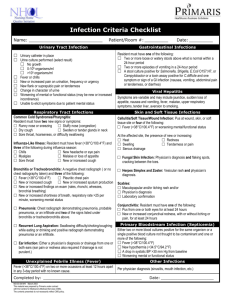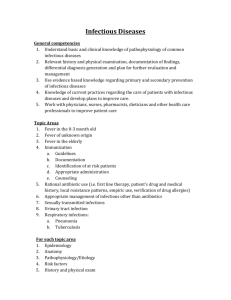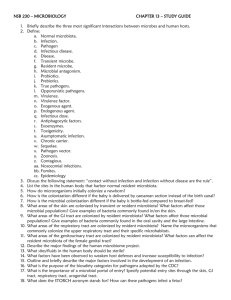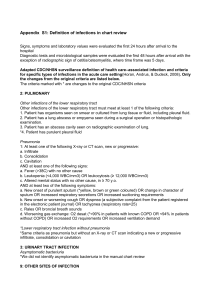Definitions of Infection for Surveillance in Long
advertisement
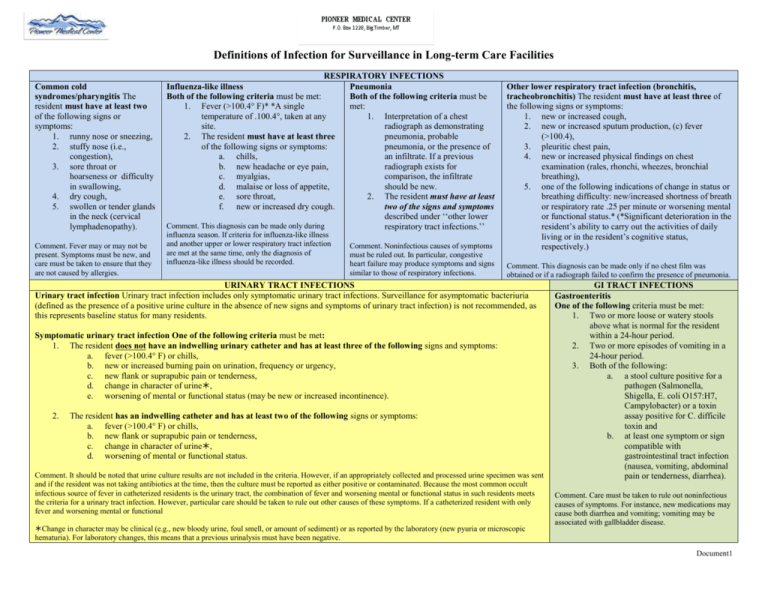
Definitions of Infection for Surveillance in Long-term Care Facilities Common cold syndromes/pharyngitis The resident must have at least two of the following signs or symptoms: 1. runny nose or sneezing, 2. stuffy nose (i.e., congestion), 3. sore throat or hoarseness or difficulty in swallowing, 4. dry cough, 5. swollen or tender glands in the neck (cervical lymphadenopathy). Comment. Fever may or may not be present. Symptoms must be new, and care must be taken to ensure that they are not caused by allergies. RESPIRATORY INFECTIONS Influenza-like illness Pneumonia Both of the following criteria must be met: Both of the following criteria must be 1. Fever (>100.4° F)* *A single met: temperature of .100.4°, taken at any 1. Interpretation of a chest site. radiograph as demonstrating 2. The resident must have at least three pneumonia, probable of the following signs or symptoms: pneumonia, or the presence of a. chills, an infiltrate. If a previous b. new headache or eye pain, radiograph exists for c. myalgias, comparison, the infiltrate d. malaise or loss of appetite, should be new. e. sore throat, 2. The resident must have at least f. new or increased dry cough. two of the signs and symptoms described under ‘‘other lower Comment. This diagnosis can be made only during respiratory tract infections.’’ influenza season. If criteria for influenza-like illness and another upper or lower respiratory tract infection are met at the same time, only the diagnosis of influenza-like illness should be recorded. Comment. Noninfectious causes of symptoms must be ruled out. In particular, congestive heart failure may produce symptoms and signs similar to those of respiratory infections. Other lower respiratory tract infection (bronchitis, tracheobronchitis) The resident must have at least three of the following signs or symptoms: 1. new or increased cough, 2. new or increased sputum production, (c) fever (>100.4), 3. pleuritic chest pain, 4. new or increased physical findings on chest examination (rales, rhonchi, wheezes, bronchial breathing), 5. one of the following indications of change in status or breathing difficulty: new/increased shortness of breath or respiratory rate .25 per minute or worsening mental or functional status.* (*Significant deterioration in the resident’s ability to carry out the activities of daily living or in the resident’s cognitive status, respectively.) Comment. This diagnosis can be made only if no chest film was obtained or if a radiograph failed to confirm the presence of pneumonia. URINARY TRACT INFECTIONS Urinary tract infection Urinary tract infection includes only symptomatic urinary tract infections. Surveillance for asymptomatic bacteriuria (defined as the presence of a positive urine culture in the absence of new signs and symptoms of urinary tract infection) is not recommended, as this represents baseline status for many residents. Symptomatic urinary tract infection One of the following criteria must be met: 1. The resident does not have an indwelling urinary catheter and has at least three of the following signs and symptoms: a. fever (>100.4° F) or chills, b. new or increased burning pain on urination, frequency or urgency, c. new flank or suprapubic pain or tenderness, d. change in character of urine, e. worsening of mental or functional status (may be new or increased incontinence). 2. The resident has an indwelling catheter and has at least two of the following signs or symptoms: a. fever (>100.4° F) or chills, b. new flank or suprapubic pain or tenderness, c. change in character of urine, d. worsening of mental or functional status. Comment. It should be noted that urine culture results are not included in the criteria. However, if an appropriately collected and processed urine specimen was sent and if the resident was not taking antibiotics at the time, then the culture must be reported as either positive or contaminated. Because the most common occult infectious source of fever in catheterized residents is the urinary tract, the combination of fever and worsening mental or functional status in such residents meets the criteria for a urinary tract infection. However, particular care should be taken to rule out other causes of these symptoms. If a catheterized resident with only fever and worsening mental or functional Change in character may be clinical (e.g., new bloody urine, foul smell, or amount of sediment) or as reported by the laboratory (new pyuria or microscopic hematuria). For laboratory changes, this means that a previous urinalysis must have been negative. GI TRACT INFECTIONS Gastroenteritis One of the following criteria must be met: 1. Two or more loose or watery stools above what is normal for the resident within a 24-hour period. 2. Two or more episodes of vomiting in a 24-hour period. 3. Both of the following: a. a stool culture positive for a pathogen (Salmonella, Shigella, E. coli O157:H7, Campylobacter) or a toxin assay positive for C. difficile toxin and b. at least one symptom or sign compatible with gastrointestinal tract infection (nausea, vomiting, abdominal pain or tenderness, diarrhea). Comment. Care must be taken to rule out noninfectious causes of symptoms. For instance, new medications may cause both diarrhea and vomiting; vomiting may be associated with gallbladder disease. Document1 Conjunctivitis One of the following criteria must be met: 1. Pus appearing from one or both eyes, present for at least 24 hours. 2. New or increased conjunctival redness, with or without itching or pain, present for at least 24 hours (also known as ‘‘pink eye’’). Comment. Symptoms must not be due to allergy or trauma to the conjunctiva. EYE, EAR, NOSE, AND MOUTH INFECTION Ear infection One of the following criteria must be met: 1. Diagnosis by a provider* of any ear infection. 2. New drainage from one or both ears. (Non-purulent drainage must be accompanied by additional symptoms, such as ear pain or redness.) *Requires a written note or a verbal report from a provider specifying the diagnosis. usually implies direct assessment of the resident by a provider. An antibiotic order alone does not fulfill this criterion. Mouth and perioral infection Oral and perioral infections, including oral candidiasis, must be diagnosed by a provider or a dentist. Sinusitis The diagnosis of sinusitis must be made by a pprovider. Cellulitis/soft tissue/wound infection One of the following criteria must be Fungal skin infection The resident must have Herpes simplex and herpes zoster infection. For a diagnosis met: both of cold sores or shingles, the resident must have both 1. Pus present at a wound, skin, or soft tissue site. 1. a maculopapular rash and 1. a vesicular rash and 2. The resident must have four or more of the following signs or 2. either provider diagnosis or laboratory 2. either provider diagnosis or laboratory confirmation. symptoms: confirmation.† a. fever (>100.4) or worsening mental/functional status; Scabies The resident must have both and/or, at the affected site, the presence of new or increasing †For Candida or other yeast, laboratory 1. a maculopapular and/or itching rash and b. heat, confirmation includes positive smear for yeast or 2. either provider diagnosis or laboratory confirmation. c. redness, culture for Candida spp.; for herpetic infections, Comment. Care must be taken to ensure that a rash is not allergic or d. swelling, positive electron microscopy or culture of secondary to skin irritation. e. tenderness or pain, scraping or swab; for scabies, positive f. serous drainage. microscopic examination of scrapings. SYSTEMIC INFECTIOJN Principles: The definitions presented here are not all-inclusive. They Primary bloodstream infection One of the following criteria must be met: focus on infections for which surveillance is expected to be useful 1. Two or more blood cultures positive for the same organism. (i.e., infections that are common and can be acquired and detected in 2. A single blood culture documented with an organism thought not to be a contaminant and at least one of the the facility). Three important conditions apply to all of the definitions: following: 1. All symptoms must be new or acutely worse. Many residents have a. fever (>/= 100.4), chronic symptoms, such as cough or urinary urgency, that are not b. new hypothermia (<94.1° F, or does not register on the thermometer being used), associated with infection. However, a change in the resident’s status is c. a drop in systolic blood pressure of > 30 mm Hg from baseline, or an important indication that an infection may be developing. 2. d. worsening mental or functional status. Noninfectious causes of signs and symptoms should always be Comment. Bloodstream infections related to infection at another site are reported as secondary bloodstream infections and are considered before a diagnosis of infection is made. 3. Identification of infection should not be based on a single piece of evidence. not included as separate infections. Microbiologic and radiologic findings should be used only to confirm clinical evidence of infection. Similarly, provider diagnosis should be Unexplained febrile episode The resident must have documentation in the medical record of fever (>/=100.4° F) on two or accompanied by compatible signs and symptoms of infection. more occasions at least 12 hours apart in any 3-day period, with no known infectious or noninfectious cause. Reference: Definitions of Infection for Surveillance in Long-term Care Facilities; Allison McGeer, Beverly Campbell, T. Grace Emori, Walter J. Hierholzer, Marguerite M. Jackson, Lindsay E. Nicolle, Carla Peppler, Amersolo Rivera, Debra G. Schollenberger, Andrew E. Simor, Philip W. Smith, and Elaine E-L. Wang Copyright 1996, APIC Document1
